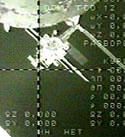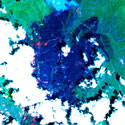
Image credit: NASA
A Progress supply ship lifted off from the Baikonur Cosmodrome in Kazakhstan on Wednesday to deliver fuel, supplies and equipment to the International Space Station. The Progress 8 spacecraft is scheduled to dock with the station early Saturday. The docking port that the Progress will use was vacated on Tuesday by the station’s previous Progress cargo ship, now filled with garbage. It was de-orbited and burned up in the Earth’s atmosphere.
A Russian Progress resupply craft was successfully launched today from the Baikonur Cosmodrome in Kazakhstan to bring fuel, supplies and equipment to the International Space Station.
The Progress 8 spacecraft lifted off on a Soyuz rocket at 12:37 a.m. CDT. About nine minutes later its solar rays and navigational antennas deployed in response to preprogrammed commands, and the umpiloted cargo carrier was safely in orbit.
Progress 8 is scheduled to dock with the space station early Saturday, where Expedition 5 crewmembers, Commander Valery Korzun, Astronaut Peggy Whitson and Cosmonaut Sergei Treschev, will begin unloading its cargo. The Progress can carry about 7,000 pounds into orbit, including fuel for the Zvezda Service Module’s attitude control thrusters.
A series of rendezvous burns by the Progress 8 engines over the next three days will result in its docking to the aft port of the Zvezda Service Module at about 1:25 a.m. CDT Saturday over Central Asia. That port was vacated Tuesday when the Progress 7 was undocked with its load of trash and deorbited to a fiery destruction in the Earth’s atmosphere.
Original Source: NASA News Release


